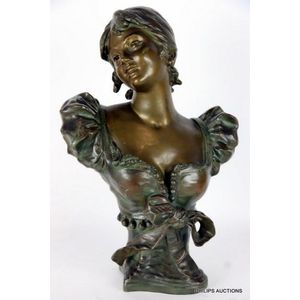Bronze Belle Epoque Lady by Louis Moreau
A spelter Belle Epoque lady by Louis Moreau (1855-1919), late 19th century, the smiling figure of a young lady in a modish dress with puff sleeves and a buttoned bodice, in bronze and gold colours, inscribed mark of L. Moreau to side, height 40 cm
You must be a subscriber, and be logged in to view price and dealer details.
Subscribe Now to view actual auction price for this item
When you subscribe, you have the option of setting the currency in which to display prices to $Au, $US, $NZ or Stg.
This item has been sold, and the description, image and price are for reference purposes only.
- Belle Epoque - The Belle Époque, also known as the "Beautiful Era," was a period in European history that lasted from the late 19th century to the outbreak of World War I in 1914. The term is most commonly associated with France, but is also used to refer to the same period in other countries, particularly in Western Europe and Latin America.
During the Belle Époque, Europe experienced a time of great prosperity and cultural, artistic, and scientific advancements. It was an era of peace and optimism, characterized by industrial growth, urbanization, and new technologies such as electricity, automobiles, and the telephone. The period is also associated with a flourishing of art and culture, particularly in the fields of literature, music, and the visual arts. - Bronze - An alloy of copper and tin, traditionally in the proportions of about 9 parts of copper to 1 part of tin.
The discovery of bronze in Western Asia in the 4th century enabled people to create metal objects which were superior to those previoulsy possible because of its strength and hardness, and it has been used throughout the world for weapons, coins, tools, statuary and other decorative items.
It is very fluid in a molten state, and its hardness, strength when set, and non-corrosive properties makes it most suitable for casting sculpture. - Spelter - Spelter was the name given to an alloy of zinc and brass or copper used in the 19th century for statuary and lighting. It is a brittle bluish-white metal. It was used as a cheap replacement for bronze, but being brittle easily breaks and can't be repaired. When finished it can often be mistaken for bronze, but if discreet a scratch on the base displays shows a greyish colour, the metal is spelter, if a golden colour the metal is most likely bronze.
This item has been included into following indexes:
